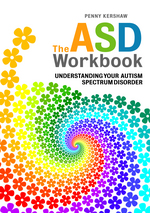 by Penny Kershaw
by Penny Kershaw
This easy-to-use interactive workbook gives parents the help they need to explain ASDs to their child and provide practical and emotional support following diagnosis.
Full Description:
A diagnosis of an Autism Spectrum Disorder (ASD) can be confusing and overwhelming for all involved, and it can be difficult for parents to know how best to approach the subject with their child. This easy-to-use interactive workbook gives parents the help they need to explain ASDs to their child and provide practical and emotional support following diagnosis.
Parents are invited to work through each chapter with their child as they grow older and go through adolescence, encouraging them to talk through how the ASD affects each area of their life, from making friends to problem-solving to planning a career. The information and advice is presented in a clear and positive way to help both parent and child understand more about what the diagnosis means for them. As the workbook is completed an invaluable record of development will be created for parent and child to look back on together.
This hands-on workbook is an essential resource for parents and carers looking for guidance on explaining ASDs from diagnosis onwards to children aged 10 and up.
10in x 7in, 144pp
About the Author. Preface for Parents and Carers. Why this book was written. Aims of this book. Who is this book for? When to use this book. How to use this book. Introducing ASDs: Checklist. 1. Introduction. Learning about autism spectrum disorders (ASDs). 2. What is an ASD? What does the diagnosis mean? Why have I got this diagnosis? What to do next. 3. Understanding Your Differences. People with an ASD are different. People with an ASD sometimes have problems. Understanding more about an ASD - the difficulties and the good things. Liking systems, patterns or routines. Social skills. Communication. Sensory sensitivity. What to do next. 4. People You Live With. Why is home life important? Problems you might have in a family. Difficulties that your family might have with your ASD. What to do next. 5. Friendships and Relationships. Why is it a good idea to make friends? What is friendship? How to make friends. How to build up a friendship. What is a boyfriend or girlfriend. Meeting the right boyfriend or girlfriend. What to do next. 6. Strengths and Interests. What are strengths and interests? Why is it important to recognise your strengths and interests? How are your strengths and interests different to those of people without an ASD? Why might your strengths and interests cause difficulties? What to do next. 7. School. Why do people have to go to school? Why school may sometimes be a challenge for you if you have an ASD. Thinking about school. What you can do to improve what school is like for you. How you can plan your career. Job applications. What to do next. 8. Getting Help. What is self-help? Why do you need to develop ways to help yourself? What might you need help with? Self-help plan. Some things to think about. What to do next. 9. Further Information. Recommended reading for people with an ASD. Recommended reading for parents and carers. Websites for parents and carers. 10. Glossary. Appendix: Progress Chart.
|